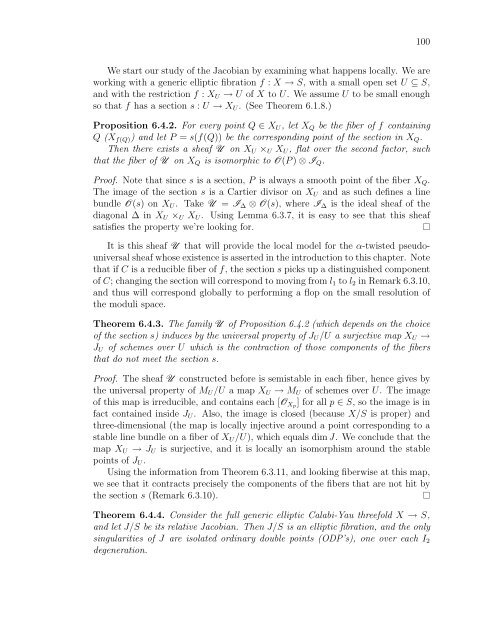derived categories of twisted sheaves on calabi-yau manifolds
derived categories of twisted sheaves on calabi-yau manifolds
derived categories of twisted sheaves on calabi-yau manifolds
Create successful ePaper yourself
Turn your PDF publications into a flip-book with our unique Google optimized e-Paper software.
100<br />
We start our study <str<strong>on</strong>g>of</str<strong>on</strong>g> the Jacobian by examining what happens locally. We are<br />
working with a generic elliptic fibrati<strong>on</strong> f : X → S, with a small open set U ⊆ S,<br />
and with the restricti<strong>on</strong> f : XU → U <str<strong>on</strong>g>of</str<strong>on</strong>g> X to U. We assume U to be small enough<br />
so that f has a secti<strong>on</strong> s : U → XU. (See Theorem 6.1.8.)<br />
Propositi<strong>on</strong> 6.4.2. For every point Q ∈ XU, let XQ be the fiber <str<strong>on</strong>g>of</str<strong>on</strong>g> f c<strong>on</strong>taining<br />
Q (Xf(Q)) and let P = s(f(Q)) be the corresp<strong>on</strong>ding point <str<strong>on</strong>g>of</str<strong>on</strong>g> the secti<strong>on</strong> in XQ.<br />
Then there exists a sheaf U <strong>on</strong> XU ×U XU, flat over the sec<strong>on</strong>d factor, such<br />
that the fiber <str<strong>on</strong>g>of</str<strong>on</strong>g> U <strong>on</strong> XQ is isomorphic to O(P ) ⊗ IQ.<br />
Pro<str<strong>on</strong>g>of</str<strong>on</strong>g>. Note that since s is a secti<strong>on</strong>, P is always a smooth point <str<strong>on</strong>g>of</str<strong>on</strong>g> the fiber XQ.<br />
The image <str<strong>on</strong>g>of</str<strong>on</strong>g> the secti<strong>on</strong> s is a Cartier divisor <strong>on</strong> XU and as such defines a line<br />
bundle O(s) <strong>on</strong> XU. Take U = I∆ ⊗ O(s), where I∆ is the ideal sheaf <str<strong>on</strong>g>of</str<strong>on</strong>g> the<br />
diag<strong>on</strong>al ∆ in XU ×U XU. Using Lemma 6.3.7, it is easy to see that this sheaf<br />
satisfies the property we’re looking for.<br />
It is this sheaf U that will provide the local model for the α-<str<strong>on</strong>g>twisted</str<strong>on</strong>g> pseudouniversal<br />
sheaf whose existence is asserted in the introducti<strong>on</strong> to this chapter. Note<br />
that if C is a reducible fiber <str<strong>on</strong>g>of</str<strong>on</strong>g> f, the secti<strong>on</strong> s picks up a distinguished comp<strong>on</strong>ent<br />
<str<strong>on</strong>g>of</str<strong>on</strong>g> C; changing the secti<strong>on</strong> will corresp<strong>on</strong>d to moving from l1 to l2 in Remark 6.3.10,<br />
and thus will corresp<strong>on</strong>d globally to performing a flop <strong>on</strong> the small resoluti<strong>on</strong> <str<strong>on</strong>g>of</str<strong>on</strong>g><br />
the moduli space.<br />
Theorem 6.4.3. The family U <str<strong>on</strong>g>of</str<strong>on</strong>g> Propositi<strong>on</strong> 6.4.2 (which depends <strong>on</strong> the choice<br />
<str<strong>on</strong>g>of</str<strong>on</strong>g> the secti<strong>on</strong> s) induces by the universal property <str<strong>on</strong>g>of</str<strong>on</strong>g> JU/U a surjective map XU →<br />
JU <str<strong>on</strong>g>of</str<strong>on</strong>g> schemes over U which is the c<strong>on</strong>tracti<strong>on</strong> <str<strong>on</strong>g>of</str<strong>on</strong>g> those comp<strong>on</strong>ents <str<strong>on</strong>g>of</str<strong>on</strong>g> the fibers<br />
that do not meet the secti<strong>on</strong> s.<br />
Pro<str<strong>on</strong>g>of</str<strong>on</strong>g>. The sheaf U c<strong>on</strong>structed before is semistable in each fiber, hence gives by<br />
the universal property <str<strong>on</strong>g>of</str<strong>on</strong>g> MU/U a map XU → MU <str<strong>on</strong>g>of</str<strong>on</strong>g> schemes over U. The image<br />
<str<strong>on</strong>g>of</str<strong>on</strong>g> this map is irreducible, and c<strong>on</strong>tains each [OXp] for all p ∈ S, so the image is in<br />
fact c<strong>on</strong>tained inside JU. Also, the image is closed (because X/S is proper) and<br />
three-dimensi<strong>on</strong>al (the map is locally injective around a point corresp<strong>on</strong>ding to a<br />
stable line bundle <strong>on</strong> a fiber <str<strong>on</strong>g>of</str<strong>on</strong>g> XU/U), which equals dim J. We c<strong>on</strong>clude that the<br />
map XU → JU is surjective, and it is locally an isomorphism around the stable<br />
points <str<strong>on</strong>g>of</str<strong>on</strong>g> JU.<br />
Using the informati<strong>on</strong> from Theorem 6.3.11, and looking fiberwise at this map,<br />
we see that it c<strong>on</strong>tracts precisely the comp<strong>on</strong>ents <str<strong>on</strong>g>of</str<strong>on</strong>g> the fibers that are not hit by<br />
the secti<strong>on</strong> s (Remark 6.3.10).<br />
Theorem 6.4.4. C<strong>on</strong>sider the full generic elliptic Calabi-Yau threefold X → S,<br />
and let J/S be its relative Jacobian. Then J/S is an elliptic fibrati<strong>on</strong>, and the <strong>on</strong>ly<br />
singularities <str<strong>on</strong>g>of</str<strong>on</strong>g> J are isolated ordinary double points (ODP’s), <strong>on</strong>e over each I2<br />
degenerati<strong>on</strong>.
















